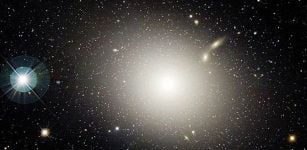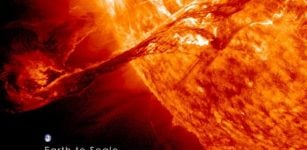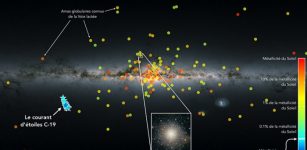Detection Of The Nanohertz Gravitational-Wave Background – New Step Taken By Researchers
Eddie Gonzales Jr. – MessageToEagle.com – The European Pulsar Timing Array collaboration reports on the outcome of a 24 year observing campaign with five large-aperture radio telescopes in Europe, resulting in a candidate signal for the since-long sought gravitational wave background due to in-spiraling supermassive black-hole binaries.
The collaboration brings together teams of astronomers around the largest European radio telescopes including the 100-m Effelsberg radio telescope of the Max Planck Institute for Radio Astronomy in Bonn, Germany, as well as groups specialized in data analysis and modeling of gravitational wave signals.
Although a detection cannot be claimed yet, this represents a significant step in the effort to finally unveil gravitational waves at very low frequencies in the Nanohertz regime. The candidate signal has emerged from an unprecedented detailed analysis using two independent methodologies and shares strong similarities with results found from the analyses of other teams.
The European Pulsar Timing Array is a scientific collaboration bringing together teams of astronomers around the largest European radio telescopes, as well as groups specialized in data analysis and modelling of gravitational wave signals. It has published a detailed analysis of a candidate signal for the since-long sought gravitational wave background due to in-spiraling supermassive black-hole binaries. Although a detection cannot be claimed yet, this represents another significant step in the effort to finally unveil gravitational waves at very low frequencies, of order one billionth of a Hertz. In fact, the candidate signal has emerged from an unprecedented detailed analysis and using two independent methodologies. Moreover, the signal shares strong similarities with those found from the analyses of other teams.
The results were made possible thanks to the data collected over 24 years with five large-aperture radio telescopes in Europe (see Fig. 2). They include the 100-m Radio Telescope of the Max Planck Institute for Radio Astronomy near Effelsberg in Germany, the 76-m Lovell Telescope in Cheshire/United Kingdom, the 94-m Nançay Decimetric Radio Telescope in France, the 64-m Sardinia Radio Telescope at Pranu Sanguni, Italy and the 16 antennas of the Westerbork Synthesis Radio Telescope in the Netherlands. In the observing mode of the Large European Array for Pulsars, the telescopes of the European Pulsar Timing Array are tied together to synthesize a fully steerable 200-m dish to greatly enhance the sensitivity of the array towards gravitational waves.
Radiation beams from the pulsars’ magnetic poles circle around their rotational axes, and they are observed as pulses when they pass our line of sight, like the light of a distant lighthouse. Pulsar timing arrays are networks of very stably rotating pulsars, used as galactic-scale gravitational wave detectors. In particular, they are sensitive to very low frequency gravitational waves in the billionth-of-a-Hertz regime. This will extend the gravitational wave observing window from the high frequencies (hundreds of Hertz) currently observed by the ground-based detectors LIGO/Virgo/KAGRA. While those detectors probe short lasting collisions of stellar-mass black holes and neutron stars, Pulsar Timing Arrays can probe gravitational waves such as those emitted by systems of slowly in-spiraling supermassive black-hole binaries hosted at the centres of galaxies. The addition of the gravitational waves released from a cosmic population of these binaries forms a gravitational wave background.
“We can measure small fluctuations in the arrival times of the pulsars’ radio signal at Earth, caused by the spacetime deformation due to a passing-by very low frequency gravitational wave. In practice, these deformations manifest as sources of a very low frequency noise in the series of the observed times of arrival of the pulses, a noise which is shared by all the pulsars of a Pulsar Timing Array”, explains Dr. Yanjun Guo, researcher at the Max Planck Institute for Radio Astronomy in Bonn, a co-author of the study.
However, the amplitude of this noise is incredibly tiny (estimated to be tens to a couple of hundreds of a billionth of a second) and in principle many other effects could impart that to any given pulsar in the Pulsar Timing Array.
To validate the results, multiple independent codes with different statistical frameworks were then used to mitigate alternate sources of noise and search for the gravitational wave background. Importantly, two independent end-to-end procedures were used in the analysis for cross-consistency. Additionally, three independent methods were used to account for possible systematics in the Solar-system planetary parameters used in the models predicting the pulse arrival times, a prime candidate for false-positive gravitational wave signals.
The European Pulsar Timing Array analysis with both procedures found a clear candidate signal for a gravitational wave background and its spectral properties (i.e. how the amplitude of the observed noise varies with its frequency) remain within theoretical expectations for the noise attributable to a gravitational wave background.
Dr. Nicolas Caballero, researcher at the Kavli Institute for Astronomy and Astrophysics in Beijing and co-lead author explains: “The European Pulsar Timing Array first found indications for this signal in their previously published data set in 2015, but as the results had larger statistical uncertainties, they were only strictly discussed as upper limits. Our new data now clearly confirm the presence of this signal, making it a candidate for a gravitational wave background “.
Einstein’s General Relativity predicts a very specific relation among the spacetime deformations experienced by the radio signals coming from pulsars located in different directions in the sky. Scientists call that as the spatial correlation of the signal, or Hellings and Downs curve. Its detection will uniquely identify the observed noise as due to a gravitational wave background. Dr. Siyuan Chen, researcher at the Laboratoire de Physique et de Chimie de l’Environnement et de l’Espace in Orleans, co-lead author of the study, notes: “At the moment, the statistical uncertainties in our measurements do not allow us yet to identify the presence of spatial correlation expected for the gravitational-wave background signal. For further confirmation we need to include more pulsar data into the analysis, however the current results are very encouraging.”
The European Pulsar Timing Array is a founding member of the International Pulsar Timing Array. As analyses of independent data performed by the other partners in the International Pulsar Timing Array (i.e. the NANOGrav and the PPTA experiments) also indicated similar common signals, it has become vital to apply multiple analysis algorithms to increase confidence in a possible future detection of the gravitational wave background. The members of the International Pulsar timing Array are working together, drawing conclusions from comparing their data and analyses to better prepare for the next steps.
Prof. Dr. Michael Kramer, director at the Max Planck Institute for Radio Astronomy and member of the Steering Committee of the European Pulsar Timing Array, concludes: “Confirming the low-frequency Gravitational Wave Background in the Nanohertz regime from a population of supermassive black hole binaries – or from another kind of cosmic source – will give us a unique insight into cosmological models by imposing strong quantitative constraints on the process of assembling the galaxies that we observe today. We are increasing our efforts by currently analysing even larger and better data sets that allow us to conduct more corresponding cross-checks, finally leaving no room for mistakes.”
Written by Eddie Gonzales Jr. MessageToEagle.com Staff

![Artistic impression of the European Pulsar Timing Array experiment. A coordinated network of European radio telescopes… [more] © Michael Kramer/MPIfR](https://www.messagetoeagle.com/wp-content/uploads/2021/10/EuropeanPulsarTimingArray11.jpg)
![Radio telescopes of the EPTA network. Clockwise from upper left: Effelsberg 100-m Radio Telescope (Germany), Nançay… [more] © Norbert Tacken/MPIfR (Effelsberg), Letourneur and Nançay Observatory (Nançay), Anthony Holloway (Jodrell Bank),… [more]](https://www.messagetoeagle.com/wp-content/uploads/2021/10/nanohertztelescope111.jpg)









